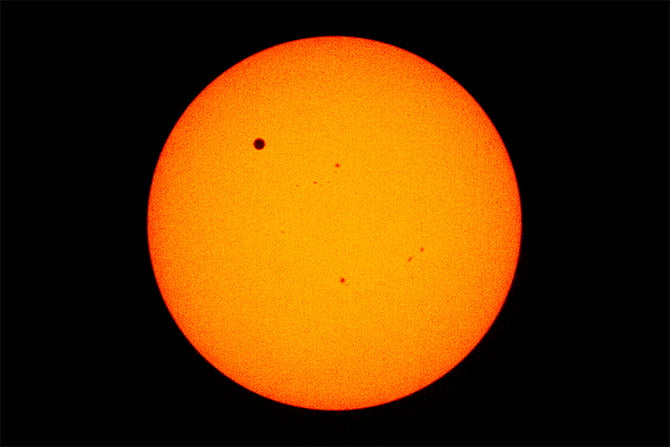To Find Alien Worlds, First Look at Our Sun – One well-trusted method of finding an exoplanet is to see how much wobble it induces in its parent star. Right now, the state of the art precision for detecting planets a few dozen light-years away via this method is about one meter per second, which is produced by planets more massive than Earth. But if something disturbs the surface of the star — say, a sunspot — this can mess with the measurements and produce false positives.
A team of researchers is hoping to get around this by doing a test study on our own sun. If it works out, their project will allow them to detect Venus orbiting the sun using this “radial velocity” technique. This will be a proof of concept for finding Earth-size or smaller planets around other stars.
“We decided to build an instrument that was able to get radial velocity of the sun as if it was another star,” said Xavier Dumusque, an astrophysicist and data scientist at Geneva Observatory, in an e-mail to Discovery News. He co-led the study with David F. Phillips of the Harvard-Smithsonian Center for Astrophysics.
“The sun is extremely close,” he added, “so we can resolve its surface and therefore see the different sunspots on its surface. By comparing resolved images of the sun and the radial velocity obtained with this new instrument, we hope to understand better the effect of sunspots on radial velocity measurements, and find optimal correction techniques applicable to other stars.”

Credit: Y. Beletsky (LCO)/ESO
A test run over seven days, using the HARPS-N instrument on a 3.6-meter telescope in Chile, showed promising results. They rigged a solar telescope to pass the sunlight of the entire disc (just like a distant star) into the instrument, which is generally used to hunt exoplanets by night. They then calibrated the light with an “astro-comb”, a device used by spectrographs to detect star wobbles. They plan to repeat this technique during every clear day for the next two to three years.
“The first data obtained with this new instrument show that we reach a precision on the sun of 0.5 meters per second. We are therefore at the precision we wanted,” Dumusque wrote. “We also show that at first order, the radial velocity variation observed on the sun can be estimated using the full disc photometry (the total light emitted by the sun). This is not surprising because sunspots are darker than than the surface of the sun, and therefore induce a variation in photometry.”

Credit: NASA
To be sure, planets that are Earth’s size and smaller have been detected around small stars very far away from us, usually using the Kepler space telescope — a prolific planet-hunting device. However, this proves a challenge for planets that are much closer to us and orbiting bright stars. Kepler looks at how much the light dims as the planet passes in front of a star. A small planet going across a bright star could slip by unnoticed.
Precision measurements of stars and understanding how sunspots affect those measurements is one of the main challenges of using radial velocity to hunt planets close to Earth, Dumusque added. “Solving for this problem will allows us to detect planets extremely similar than Earth orbiting around bright stars. Those candidates will then be observed with the future generation of extremely large telescopes, to look for traces of life in their atmospheres.”
There will be more observatories launching shortly to look for planets close to Earth’s size. Examples are the James Webb Space Telescope (2018), the Transiting Exoplanet Survey Satellite (no later than 2018) and on Earth, the European Extremely Large Telescope, which should see first light in 2024. While these observatories still have to be tested, scientists are hoping we can start to see Earth-sized planetary atmospheres with at least some of the telescopes.
Source: space




